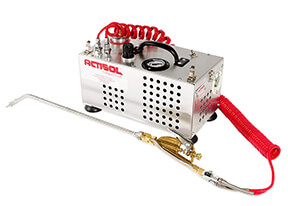How I love that wonderful hum of an Actisol machine! The pitter patter of roaches falling from greasy poorly maintained kitchen equipment, the hiss from the wand.
It almost makes me miss the days of commercial kitchen cleanouts. Then memories of painful knees due to hours of crawling on tile floors quickly remedies my nostalgia.
 These wonderful tools offer an excellent solution for delivering products into deep and difficult-to-treat voids and harborages. This unit was not designed to space treat entire rooms (yes, I have seen it done), but there are better methods for space sprays.
These wonderful tools offer an excellent solution for delivering products into deep and difficult-to-treat voids and harborages. This unit was not designed to space treat entire rooms (yes, I have seen it done), but there are better methods for space sprays.
The compact unit is designed to fill small voids with product, killing pests in their hiding places or flushing them out to run through your residual treatment. Think of them as the ultimate aerosol can. They can be used with both oil- and water-based insecticides making them very versatile.
Additional uses are made with customized extension wands to allow applications into eaves and other common bee nesting sites. These extended wands reduce the need for ladders and allows pinpoint application from further distances.
Watch Your Pressure Control
These long-range applications are where pressure control becomes critical. The higher you go the higher your pressure will need to be.
I know we all have the impulse to crank the unit to 25psi when flushing, but don’t. You want lower pressures to allow product to flow thru the void not blast the back wall and run down as a liquid. This just creates a puddle and more cleanup at the end of a job.
Daily Maintenance: Backflushing
More recently Actisols have been increasingly used to deliver sanitizers. Whatever you use I highly recommend backflushing at the end of each day to ensure your equipment is ready for use the next time you need it.
For backflushing instructions, see our Actisol Maintenance blog and video tutorial. To learn more about the machine, visit Actisol.com.
